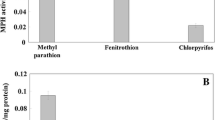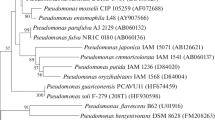Abstract
Pseudomonas sp. N31 was isolated from soil using 3-nitrophenol and succinate as sole source of nitrogen and carbon respectively. The strain expresses a nitrophenol oxygenase and can use either 2-nitrophenol or 4-chloro-2-nitrophenol as a source of nitrogen, eliminating nitrite, and accumulating catechol and 4-chlorocatechol, respectively. The catechols were not degraded further. Strains which are able to utilize 4-chloro-2-nitrophenol as a sole source of carbon and nitrogen were constructed by transfer of the haloaromatic degrading sequences from either Pseudomonas sp. B13 or Alcaligenes eutrophus JMP134 (pJP4) to strain N31. Transconjugant strains constructed using JMP134 as the donor strain grew on 3-chlorobenzoate but not on 2,4-dichlorophenoxyacetate. This was due to the non-induction of 2,4-dichlorophenoxyacetate monooxygenase and 2,4-dichlorophenol hydroxylase. Transfer of the plasmid from the 2,4-dichlorophenoxyacetate negative transconjugant strains to a cured strain of JMP134 resulted in strains which also had the same phenotype. This indicates that a mutation has occurred in pJP4 to prevent the expression of 2,4-dichlorophenoxyacetate monooxygenase and 2,4-dichlorophenol hydroxylase.
Similar content being viewed by others
References
Bradford MM (1976) A rapid and sensitive method for the quantitation of microgram quantities of protein utilizing the principle of protein-dye binding. Anal Biochem 72:248–254
Bruhn C, Lenke H, Knackmuss H-J (1987) Nitrosubstituted aromatic compounds as nitrogen source for bacteria. Appl Environ Microbiol 53:208–210
Cain RB (1958) The microbial metabolism of nitro-aromatic compounds. J Gen Microbiol 19:1–14
Cain RB (1966) Utilization of anthranilic and nitrobenzoic acids by Nocardia opaca and a Flavobacterium. J Gen Microbiol 42: 219–235
Deutsche Apotheker-Zeitung (1963) 48:1623
Don RH, Pemberton JM (1981) Properties of six pesticide degradation plasmid isolated from Alcaligenes paradoxus and Alcaligenes eutrophus. J Bacteriol 145:681–686
Don RH, Weightman AJ, Knackmuss H-J, Timmis KN (1985) Transposon mutagenesis and cloning analysis of the pathways for the degradation of 2,4-dichlorophenylacetic acid and 3-chlorobenzoate in Alcaligenes eutrophus JMP134 (pJP4). J Bacteriol 161:85–90
Dorn E, Hellwig M, Reineke W, Knackmuss H-J (1974) Isolation and characterization of a 3-chlorobenzoate degrading pseudomonad. Arch Microbiol 99:61–70
Dorn E, Knackmuss H-J (1978) Chemical structure and biodegradability of halogenated aromatic compounds: two catechol 1,2-dioxygenases from a 3-chlorobenzoate-grown pseudomonad. Biochem J 174:73–84
Friedrich B, Meyer M, Schlegel HG (1983) Transfer and expression of the herbicide-degrading plasmid pJP4 in aerobic autotrophic bacteria. Arch Microbiol 134:92–97
Fritz H (1987) Untersuchungen zum mikrobiellen Abbau von 3-Nitrophenol. Diplomarbeit, Univ Bonn, FRG
Germanier F, Wuhrmann K (1963) Über den aeroben mikrobiellen Abbau aromatischer Nitroverbindungen. Pathol Microbiol 26:569–578
Haas R, Löw E v (1986) Grundwasserbelastung durch eine Altlast. Die Folgen einer ehemaligen Sprengstoffproduktion für die heutige Trinkwassergewinnung. Forum Städte-Hygiene 37: 33–43
Jensen HL, Lautrup-Larsen G (1967) Microorganisms that decompose nitro-aromatic compounds, with special reference to dinitro-orthocresol. Acta Agric Scand 17:115–125
Ke Y-H, Gee LC, Durham NN (1959) Mechanism involved in the metabolism of nitrophenylcarboxylic acid compounds by microorganisms. J Bacteriol 77:593–598
Latorre J, Reineke W, Knackmuss H-J (1984) Microbial metabolism of chloroanilines: enhanced envolution by natural genetic exchange. Arch Microbiol 140:159–165
Montgomery HAC, Dymoc JF (1961) The determination of nitrite in water. Analyst 86:414–416
Murthy NBK, Kaufmann DD (1978) Degradation of pentachloronitrobenzene (PCNB) in anaerobic soils. J Agric Food Chem 26:1151–1156
Pemberton JM, Corney B, Don RH (1979) Evolution and spread of pesticide degrading ability among soil micro-organisms. In: Timmis KN, Pühler A (eds) Plasmids of medical, environmental and commercial importance. Elsevier/North Holland Biochemical Press. Amsterdam, pp 287–299
Pieper D (1986) Metabolismus von substituierten Phenoxyacetaten, Phenolen und Benzoaten durch Alcaligenes eutrophus JMP134 und Derivate. Dissertation, Univ Wuppertal, FRG
Pieper D, Reineke W, Engesser K-H, Knackmuss H-J (1988) Metabolism of 2,4-dichlorophenoxyacetic acid, 4-chloro-2-methylphenoxyacetic acid and 2-methylphenoxyacetic acid by Alcaligenes eutrophus JMP134. Arch Microbiol 150:95–102
Raymond DGM, Alexander M (1971) Microbial metabolism and cometabolism of nitrophenols. Pestic Biochem Physiol 1:123–130
Rubio MA, Engesser KH, Knackmuss H-J (1986) Microbial metabolism of chlorosalicylates: accelerated evolution by natural genetic exchange. Arch Microbiol 145:116–122
Schmidt E, Knackmuss H-J (1980) Chemical structure and biodegradability of halogenated aromatic compounds. Conversion of chlorinated muconic acids into maleylacetic acid. Biochem J 192:339–347
Schmidt E, Remberg G, Knackmuss H-J (1980) Chemical structure and biodegradability of halogenated aromatic compounds. Halogenated muconic acids as intermediates. Biochem J 192:331–337
Simon EW (1953) Mechanisms of dinitrophenol toxicity. Biol Rev 28:453–479
Spain JC, Wyss O, Gibson DT (1979) Enzymatic oxidation of p-nitrophenol. Biochem Biophys Res Commun 88:634–641
Streber WR, Timmis KN, Zenk MH (1987) Analysis, cloning, and high-level expression of 2,4-dichlorophenoxyacetate monooxygenase gene tfd A of Alcaligenes eutrophus JMP134. J Bacteriol 169:2950–2955
Teuteberg A (1964) Untersuchungen über den Abbau von Halogen-nitrobenzolen durch Bodenbakterien. Arch Mikrobiol 48: 21–49
Venulet J, Van Etten RL (1970) Biochemistry and pharmacology of the nitro- and nitrosogroups. In: Feuer H (ed) The chemistry of the nitro- and nitrosogroups, vol 5 PATAI part 2. Wiley, London, pp 202–287
Wacek A, Fiedler R (1949) Über die Oxydation des Brenzcatechins zu Muconsäure. Monatsh Chem 80:170–185
Wirth W, Hecht G, Gloxhuber C (1971) Toxikologie-Fibel. Thieme, Stuttgart
Zeyer J, Kearney PC (1984) Degradation of o-nitrophenol and m-nitrophenol by a Pseudomonas putida. J Agric Food Chem 32:238–242
Zeyer J, Kocher HP, Timmis KN (1986) Influence of para-substituents on the oxidative metabolism of o-nitrophenols by Pseudomonas putida B2. Appl Environ Microbiol 52:334–339
Author information
Authors and Affiliations
Rights and permissions
About this article
Cite this article
Bruhn, C., Bayly, R.C. & Knackmuss, H.J. The in vivo construction of 4-chloro-2-nitrophenol assimilatory bacteria. Arch. Microbiol. 150, 171–177 (1988). https://doi.org/10.1007/BF00425158
Received:
Accepted:
Issue Date:
DOI: https://doi.org/10.1007/BF00425158



